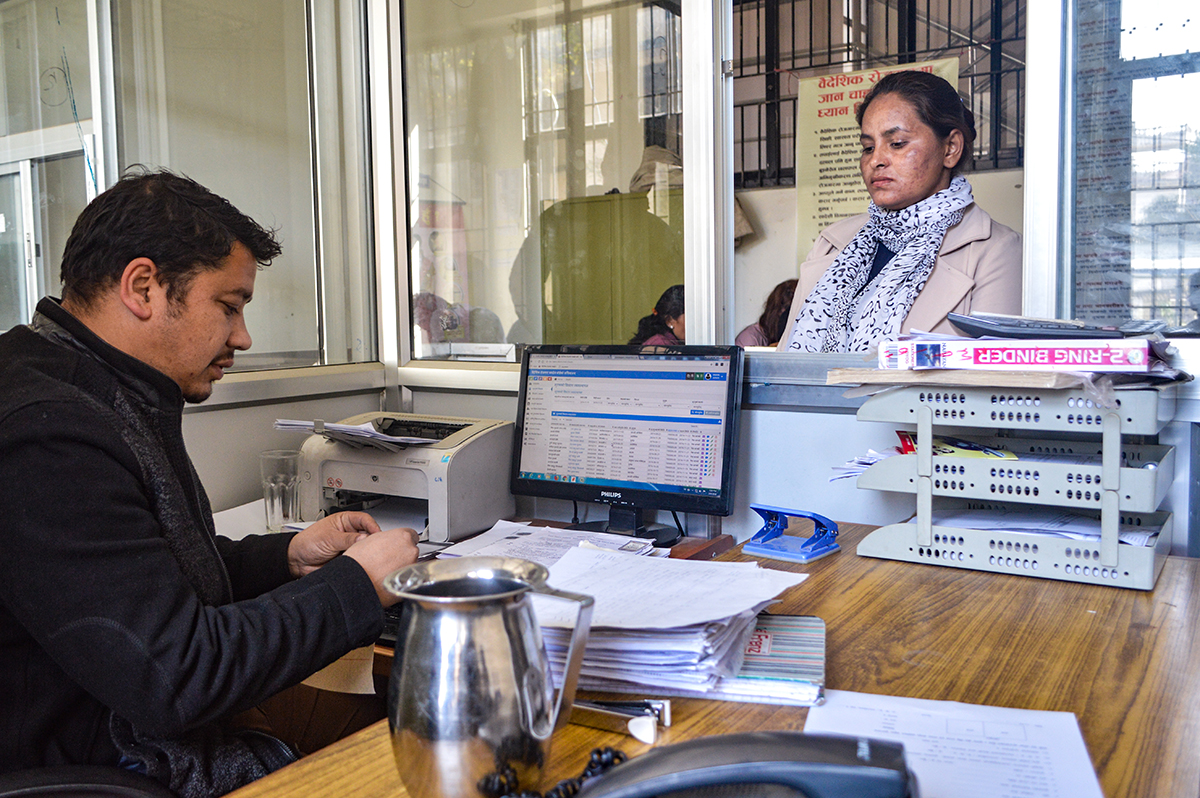

By Yam Kumari Kandel, Senior Reporter
KATHMANDU, NEPAL — Months after the Nepalese government announced a scholarship program to cover advanced education costs for the children of Nepalese migrant workers who died or were seriously injured while abroad, many family members who qualify for the scholarship say they weren’t aware of it.
In fact, it’s still news to many Nepalese families that a similar scholarship fund, created in 2015, could help in paying for their children’s primary- and secondary-school fees.
Sunita Kafle, whose husband, Raju Kafle, returned home in 2015 from working in Malaysia because he had a brain tumor, grieves that she’s struggled for years to keep her children in school. Her oldest, a son, recently completed secondary school. Her 17-year-old daughter is in her final year.
“Our days of hardship would be over if my children are economically capable,” Sunita Kafle says.
Her husband’s brain tumor was successfully treated, but his arms and legs don’t work like they used to, she says. His medical condition qualifies the family for the scholarship funds, she says, but the children don’t receive them.
The new scholarship fund, which was announced last August, covers education for engineering and nursing jobs, as well as for some vocational jobs, says Sagar Ghimire, a deputy director at the Foreign Employment Promotion Board. The board manages a welfare fund to assist Nepalese migrant workers. There were about 385,000 migrant workers abroad in the 2016-17 fiscal year, according to the board’s data.
Nepalese workers who legally leave the country for jobs elsewhere pay into the fund at 1,500 Nepalese rupees ($14.29) for a three-year work contract or 2,500 rupees ($23.82) for contracts of more than three years, Ghimire says. So far, the fund has collected 772.13 million rupees (about $7.4 million), including 60 million rupees (about $572,000) contributed by the Nepalese government.
Nearly 442 million rupees (about $4.2 million) have been paid out, Ghimire says.
“Our days of hardship would be over if my children are economically capable.”
— Sunita Kafle
The scholarship fund for primary and secondary school pays out 8,000 rupees ($76.22) and 12,000 rupees (about $115) per year, respectively, says Nir Kumar K.C., an accountant at the Foreign Employment Promotion Board.
There were 120 scholarship awards available for 2018, he says, but so far only 31 people have applied.
The government has taken out ads on radio and television stations to promote the scholarships, Ghimire says.
But, he acknowledges, a large number of Nepalese workers are abroad illegally, many of whom simply overstayed their legal work permits. Only the children of workers whose papers were up to date at the time of their injury or death are eligible for the scholarships, he says.
It’s estimated that about 1.7 million Nepalese people are working abroad illegally, says Mohan Adhikari, an undersecretary in the Ministry of Labor, Employment and Social Security.
Nepal’s total population is just under 30 million people.
Krishna Kumari B.K.’s husband went to Qatar for work in 2004. He remained there even after his work permit expired, but he was injured in a car accident. He was in a vegetative state at a hospital there for years before he was moved to Kathmandu in 2016. (Read GPJ’s coverage of his story here.)
Kumari B.K. says she received 700,000 rupees (about $6,700) in donations and from the Nepalese government to cover his care. He died in 2017, leaving her with about 200,000 rupees (about $1,900). Her two children are in school. A relative has paid for her son’s education expenses, but she takes care of her daughter’s tuition and fees, which amount to 13,000 rupees (about $124) every quarter, in addition to the annual admission cost of 20,000 rupees (about $191).
Those expenses have taken nearly all the money she has. Her children don’t qualify for the scholarship, because her husband was abroad illegally.
“That savings is about to run out,” she says
Sagar Ghimire, GPJ, translated this story from Nepali.
Sagar Ghimire, the Foreign Employment Promotion Board official named in this story, is not related to Sagar Ghimire, the GPJ translator.
This article was originally published on Global Press Journal.

